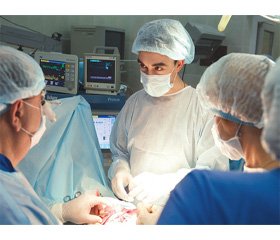Журнал «Здоровье ребенка» 6 (57) 2014
Вернуться к номеру
Extra lobes of the liver and congenital anomalies of the diaphragm in children
Авторы: I.P.Zhurylo, I.Yu.Mokrik, P.A.Lepikhov, A.A.Novak, V.P.Perunsky, A.D.Nekrasov, G.N.Turpakova - Clinic of Pediatric Surgery named after prof.N.L.Kushch of Donetsk National Medical University named after M.Gorky; Pediatric Cardiac Surgery Department of the Institute of Emergency and Reconstructive Surgery AMS of Ukraine; Regional Children''s Hospital, Donetsk, Ukraine.
Рубрики: Педиатрия/Неонатология
Разделы: Справочник специалиста
Версия для печати
Summary. Congenital abnormalities of the liver are rare. Most often this is extra lobe of the liver (ELL) or ectopic liver tissue (ELT). When ELL is a connection with the main array of hepatic parenchyma in the form of tissue or vascular-secretory pedicle. ELT is characterized by the complete absence of vascular and secretory connection with the liver. One variety of congenital anomalies of the liver is the extra lobe, named after the German surgeon B.Riedel, described the pathology in 1888. There is published data on similar ELL emanating from the left lobe of the liver, so-called Riedel-like lobe. Supradiaphragmatic and intrapleural location of ELL were described. In most cases, such ELL hasn’t clinical manifestations and detected incidentally by ultrasound or during surgery. Isolated cases of intrathoracic transposition ELL through the congenital diaphragmatic defects are extremely rare.
Aim of this study was to analyze our own observations intrathoracic location ELL and the definition of surgical tactics in this pathology. We observed 3 patients with intrathoracic location ELL. It is only about isolated cases ELL location into the chest without concomitant transposition other abdominal organs. In 2 cases the pathology was diagnosed in the neonatal period, in one - a child aged 4 years. Only one patient revealed marked clinical manifestation directly related to the presence of this anomaly. Tumor-like formation in the thoracic cavity was found accidentally by X-ray or ultrasound examination in two other cases.
The boy is 12 days, with congenital heart abnormality (tetralogy of Fallot) and transposition ELL of the left part of the liver into the thorax was performed its move into the abdominal cavity, excision of the hernia sac and alloplasty of the diaphragmatic defect. Immediate postoperative period was uneventful.
Two other observations of ELL transposition into the thorax was accidental finding during examination. There weren’t any pathological manifestations associated with intrathoracic location ELL. They weren’t indications for surgical correction of the congenital diaphragmatic hernia (CDH) in these patients.
Only one of 3 of our patients for health required surgical correction of malformation. In 2 children was chosen watchful waiting.
In all three cases were marked the various zones ELL intercalation into the thorax. We found local protrusion of the left dome of the diaphragm in operated child. Two patients had right and left retrosternal hernias. Given the place of intercalation ELL into the thorax in non-operated patients (Larrey’s and Morgagni’s zones), most likely, they were true diaphragmatic hernia.
The severe congenital heart abnormalities (CHA) were diagnosed in two patients.
Given the fact, that the formation of the diaphragm in the embryo and the movement the heart into the chest cavity occur in parallel, is not ruled out the relationship of the CHA and diaphragmatic defects. Local compression leads to focal degeneration or maldevelopment of the muscular layer of the diaphragm in the region, an exact fit abnormal liver lobe. As a result, thinner portion of the diaphragm and the ELL bulges into the chest cavity. Occurrence of CHA on the background intercalation into the thorax ELL can be explained coincidence terms of formation of the diaphragm and the separation process of the heart cavities. At this point, the diaphragm is formed, and the pressure of the ELL to the heart could negatively affect the process of separating its cavities and contribute to CHA.
Thus, intrathoracic transposition ELL is a rare congenital combined anomaly, the main its components are: the availability of extra lobe on the diaphragmatic surface of the liver and the protrusion (or defect) of the diaphragm in a local area. Clinical manifestations of this disease as cardiovascular and respiratory failure are directly dependent on the degree of compression of the mediastinum. Indications for surgical correction should be determined individually in each case. Given the interconnection embryogenesis of the liver, diaphragm, and mediastinal organs intrathoracic transposition ELL can lead to the formation of congenital heart defects.

